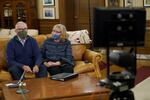
Washington Gov. Jay Inslee and his wife, Trudi, wear masks in the governor's office before making a statewide televised address on COVID-19, which health officials have warned is accelerating rapidly throughout the state, Thursday, Nov. 12, 2020, at the Capitol in Olympia, Wash.
Ted S. Warren / AP
Much like the rest of the country, Pacific Northwest states are experiencing a dramatic rise in new cases of COVID-19. Oregon and Washington have both repeatedly broken their own records in recent weeks for posting the highest daily counts of new confirmed and presumptive coronavirus cases statewide since the beginning of the pandemic. As the holiday season, in normal years, is a time for family gatherings and travel. But in 2020, amid a raging pandemic, governors in both states have enacted new rules to help mitigate the already rapid spread of the virus.
The restrictions are slightly different in each state. Northwest News Network Olympia correspondent Austin Jenkins joined OPB’s “All Things Considered” this week to compare and contrast them. You can listen to the entire conversation using the audio player at the top of this story. Here are some highlights:
On what Washington’s newly enacted COVID-19 restrictions look like:
“So it’s quite a long list, but here are the basics: Indoor social gatherings are prohibited unless people quarantine for 14 days beforehand, or, quarantine for seven days beforehand and get a negative COVID test no more than 48 hours before the gathering. Outdoor social gatherings are limited to five people from outside your household. Restaurants and bars are closed for dine-in service. Gyms, bowling alleys, theaters, museums are all having to close down again. Wedding and funeral receptions are not being allowed. No open houses for real estate, and there’s also a limit on capacity in retail settings.”
On some key differences between Oregon’s and Washington’s new rules:
"In Washington, restaurants can still serve people outside: outside dining, with up to five people at the table. In Oregon, both indoor and outdoor dining is paused. Another key difference is that Oregon is allowing grocery and retail stores to operate with up to 75% capacity, while Washington is at this 25% capacity percentage. I asked health officials here in Washington to justify this. Secretary of Health John Wiesman responded by saying that masks are not 100% effective.
"'Paying attention to what the science tells us, it says that we limit our time somewhere, limit the number of people who are there at the same time, keep your distance, cover your face. All of those things together can help us be successful,’ Wiesman said.
"I did not get an answer as to why 25% is the magic number in Washington. But I do want to note that before this latest guidance, Washington retailers were actually limited to 30% of capacity. I don’t think most people knew that. But what we did hear is that most grocers said that they actually did not need to regulate the front door at that level, because shoppers tend to spread themselves out anyway throughout the day.”
On a collective action taken by Oregon, Washington and California to limit travel:
“[The West Coast travel advisory] encourages non-essential travel to not happen. It also says, if you leave the state and come back, they want you to self-quarantine. And anybody coming into one of our West Coast states from elsewhere is asked to self-quarantine. It doesn’t look like they’re planning to enforce this, but they are asking for people to comply with it, and it sort of sets a tone and an expectation.”
On what the ‘Western States Pact' to fight COVID-19 really means in practice:
“When this pact was formed in April — and by the way, Colorado and Nevada also later joined [with Oregon, Washington and California] — it was billed by the governors as a shared vision for reopening their economies and controlling COVID-19. But, they also said at the time that each state would build its own state-specific plan, and that this was more a pact on principles. A spokesperson for Gov. Inslee told me that this Western States Pact was not about making decisions in lockstep. It was about sharing information and supporting one another when there’s need. So, there may have been kind of an expectation, when you hear the term ‘pact,’ that we’d be doing things in unison. But what I’m hearing from the governor’s office here at least, is that that wasn’t the expectation going into it, and it’s certainly not going to be the reality day-to-day, week-to-week or month-to-month.”